By Simon Garratt
There are a few remarkable facts that I’m about to show you in connection with the coral reef surrounding the tiny Island of Velidhu in the North Ari Atoll of the Maldivian Republic.
Ask any marine biologist that specialises in the coral reef environment, or any recreational diver who frequents any number of the worlds coral regions, and you will receive a common image that concerns the scientific and recreational community greatly at present. That image is of the increasing rarity of finding a reef in pristine condition—a reef that hasn’t suffered at the hands of recent climatic change, hasn’t suffered from commercial over fishing, and isn’t polluted or being smothered by the exploits of nearby land based human activity.
Of the many thousands of coral reefs around the worlds tropical belt, only a relatively small number are classed within the ranks as still thriving in the face of these various adverse factors. Reefs such as Ningaloo, Tubbataha, Maya, Grand Central Station, and The Chimneys are a few of such sites. If we are talking reefs that set the benchmark, then there are but a handful, with Kingman Reef widely accepted as the world’s best condition reef in terms of health. In fact, it’s so good, it has been termed on occasions as the last surviving example of what the pre-industrial revolution coral reef environment looked like.
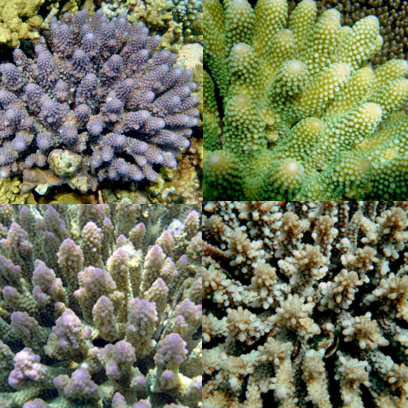 What’s depressing about the above passage is the fact that to a large degree, the human race is widely accepted as the largest factor in the dwindling occurrence of these oceanic oases. On the positive side, it’s nice to know that we haven’t cocked it up completely—we are now becoming more aware of the impact we are having even from a distance, and that there are still areas ‘usually very remote from human influence’ that are not only coping, but still thriving.
What’s depressing about the above passage is the fact that to a large degree, the human race is widely accepted as the largest factor in the dwindling occurrence of these oceanic oases. On the positive side, it’s nice to know that we haven’t cocked it up completely—we are now becoming more aware of the impact we are having even from a distance, and that there are still areas ‘usually very remote from human influence’ that are not only coping, but still thriving.
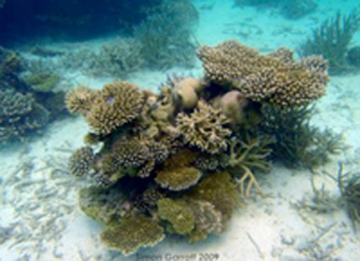 So in September 2009 it was to my utmost shock and amazement that I came across what for all intents and purposes represents a reef within the ranks of ‘thriving’, in an area I have known and explored over many years of snorkelling and diving. What shocked me even more, was that it resides smack dab in the middle of a nation that gets more than half its revenue from the tourism trade. In fact, tourism is so high on its list of priorities that there are twice as many tourists that visit the region each year, than there are people making up the native population.
So in September 2009 it was to my utmost shock and amazement that I came across what for all intents and purposes represents a reef within the ranks of ‘thriving’, in an area I have known and explored over many years of snorkelling and diving. What shocked me even more, was that it resides smack dab in the middle of a nation that gets more than half its revenue from the tourism trade. In fact, tourism is so high on its list of priorities that there are twice as many tourists that visit the region each year, than there are people making up the native population.
The Maldivian Republic Is a group of nearly 1000 small islands or atolls in the Indian ocean covering a total area of just 298 sq kilometres that support an entire nation of only 300,000 residents. With a maximum elevation above sea level of just a few meters, it represents the world’s lowest lying civilisation and the world’s most endangered civilisation with regards to sea level increase through global warming. Up until 1998 the major industry was fishing, later to be replaced by tourism. At present it tentatively holds the torch as far as environmental change is concerned, with a vow to be the first nation on the planet to be carbon neutral by 2020. Velidhu island rests within the North Ari Atoll, just 1 hour by boat or 30 min by seaplane from the nation’s capital Male. The fact it’s a holiday resort, and not a reserve, is what makes this gem of a reef even more astounding.
There is no disputing the Maldivian love for the environment, or their commitment to protecting it. It wasn’t always that way, but changes have come fast and furious as the nation realised that it had a major resource sitting in many cases just a few yards out into it’s crystal clear waters. Today, they are extremely pro active in protecting the environment from adverse influences. Admittedly, sometimes they get it a bit wrong in relation to the use of natural resources, but hey, when your stuck out in the ocean thousands of miles away from any major land mass, you really don’t have that much choice in some cases but to use what you have at hand.
Velidhu is what you would term a mini atoll. In as such the island has its own surrounding ring of permanently submerged reef with a central deep lagoon, unlike the chain Islands that make up part of the outer margins of the main larger atolls. In these cases, the islands have an outer reef running down just one side of the island, whilst the inner side forms ‘part’ of a much larger multi- island central lagoon. Large atolls can be tens of kilometres across, whilst mini atoll’s such as Velidhu may be only a kilometre or two across the whole ring of reef. In Velidhu’s case, the reef stretches in a 2 kilometer diameter, unbroken ring around the island which is set off to one side of the main central lagoon.
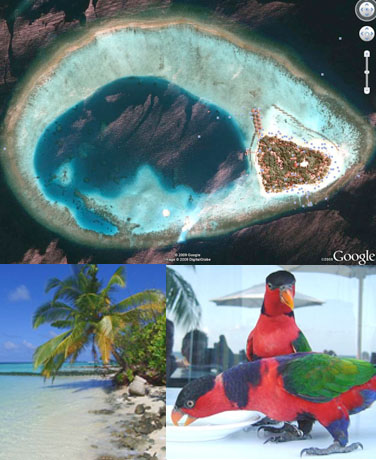 As a reef keeper, I’ll get this bit out of the way quick—the island itself is incredibly beautiful, with white powdery sands, stunning wildlife, a fantastic hotel with separate individual beach bungalow’s for guests, the food is fantastic, and the service is impeccable. In fact, it has everything you could possibly desire in a paradise setting, so have no fear, as a holiday destination. You couldn’t ask for anything more. There you go, I’ve gotten the brochure bit out of the way.
As a reef keeper, I’ll get this bit out of the way quick—the island itself is incredibly beautiful, with white powdery sands, stunning wildlife, a fantastic hotel with separate individual beach bungalow’s for guests, the food is fantastic, and the service is impeccable. In fact, it has everything you could possibly desire in a paradise setting, so have no fear, as a holiday destination. You couldn’t ask for anything more. There you go, I’ve gotten the brochure bit out of the way.
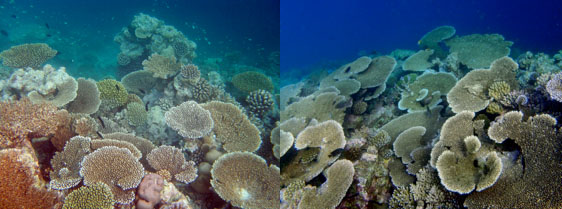 So what about the reef I hear you shouting. Well, it follows the typical traits of just about any atoll reef with a central island, whereby we enter the water into a sandy lagoon belt that runs around the island. Made up of fine aragonite sediments, this belt varies in diameter before hitting the back reef and rubble zones, from just a few meters from shore, to 30 or 40 meters. Surprisingly, Velidhu doesn’t have the wide expanse of rubble zones common in other locations around the Maldives that form a zone between the sandy shoreline and back reef or reef flat. In certain places around the island there isn’t any rubble zone to mention. You effectively go strait from a narrow substrate band dotted with individual mono-specific coral stands that have broken off from the main reef and settled in the sand to grow out to impressive proportions, to about 4ft water depth and then you hit a wall of coral that forms the back edge of the reef flat in one sharp transition. Once heading out across the reef flat which varies from 20m wide to over 100m wide at some points, you cross the permanently submerged crest, and then start falling down the 45 degree reef slope, before crossing into the void where the reef just drops away beneath you into the abyss like some giant living wall.
So what about the reef I hear you shouting. Well, it follows the typical traits of just about any atoll reef with a central island, whereby we enter the water into a sandy lagoon belt that runs around the island. Made up of fine aragonite sediments, this belt varies in diameter before hitting the back reef and rubble zones, from just a few meters from shore, to 30 or 40 meters. Surprisingly, Velidhu doesn’t have the wide expanse of rubble zones common in other locations around the Maldives that form a zone between the sandy shoreline and back reef or reef flat. In certain places around the island there isn’t any rubble zone to mention. You effectively go strait from a narrow substrate band dotted with individual mono-specific coral stands that have broken off from the main reef and settled in the sand to grow out to impressive proportions, to about 4ft water depth and then you hit a wall of coral that forms the back edge of the reef flat in one sharp transition. Once heading out across the reef flat which varies from 20m wide to over 100m wide at some points, you cross the permanently submerged crest, and then start falling down the 45 degree reef slope, before crossing into the void where the reef just drops away beneath you into the abyss like some giant living wall.
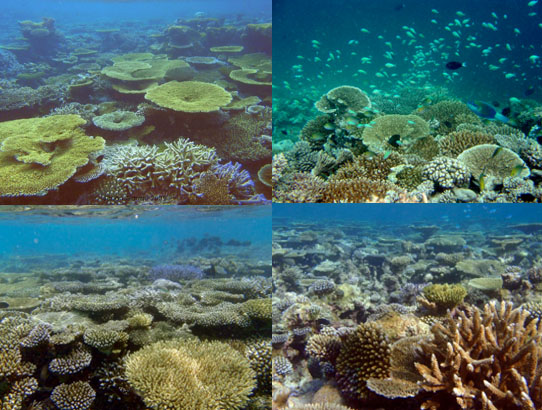 From a snorkelling perspective, you honestly could not wish for a better environment. Water clarity is extremely high depending on the plankton bloom phases, and the vast majority of reef flat expanse is between 1-2 meters off the surface depending on the tide cycle, so you can basically just float there and drift across the reef with corals and fish staring you strait in the face. It also gives you the opportunity to observe things close up and personal for decent durations, which is usually the reserve of those using full dive gear, —sometimes too close it has to be said.
From a snorkelling perspective, you honestly could not wish for a better environment. Water clarity is extremely high depending on the plankton bloom phases, and the vast majority of reef flat expanse is between 1-2 meters off the surface depending on the tide cycle, so you can basically just float there and drift across the reef with corals and fish staring you strait in the face. It also gives you the opportunity to observe things close up and personal for decent durations, which is usually the reserve of those using full dive gear, —sometimes too close it has to be said.
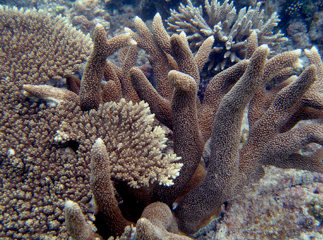 One thing that’s surprising about this reef in particular compared to many others across the Maldives is the large number of differing Acropora, Montipora and other stony coral species packed into such a small area. On most Maldivian reefs there is usually a clear trend towards one particular species being dominant across the reef flat and back reef area, with Acropora millepora being a case in point in many locations. Velidhu on the other hand is incredibly diverse. Even more impressive, this reef has virtually 100% coverage of stony corals, with very little rocky and algae covered substrate left unoccupied. This may go some way to explaining the lack of territory holding Acanthurus leucosternon pairs. In the case of Velidhu, the resident populations live as schools, flowing across the reef like huge flocks or as long stretched out trains as they move from one location to another, with only the occasional permanent pair evident who can pin down and secure the few locations that do have enough bare substrate to encourage enough algae to support them on an ongoing basis so that they don’t need to forage.
One thing that’s surprising about this reef in particular compared to many others across the Maldives is the large number of differing Acropora, Montipora and other stony coral species packed into such a small area. On most Maldivian reefs there is usually a clear trend towards one particular species being dominant across the reef flat and back reef area, with Acropora millepora being a case in point in many locations. Velidhu on the other hand is incredibly diverse. Even more impressive, this reef has virtually 100% coverage of stony corals, with very little rocky and algae covered substrate left unoccupied. This may go some way to explaining the lack of territory holding Acanthurus leucosternon pairs. In the case of Velidhu, the resident populations live as schools, flowing across the reef like huge flocks or as long stretched out trains as they move from one location to another, with only the occasional permanent pair evident who can pin down and secure the few locations that do have enough bare substrate to encourage enough algae to support them on an ongoing basis so that they don’t need to forage.
Looking between the corals, you quickly realise that this huge living mass isn’t just covering a solid substrate. Look closer and you will notice the entire population rests on several generations of their collapsed and overgrown forefathers. The net result is an underlying structure that is an incredibly intricate latticework of interconnected branches, plates, caves, tunnels and crevices, all teaming with life of every description. A huge diversity of fish species use these undercover networks like subterranean highways dipping out of sight by one coral, only to emerge a few seconds later in a completely differing location. Many Butterfly, Damsel, Angel, and Wrasse species– to name but a few are flitting about constantly. Such is the nature and intricate makeup of this reef that you can spend literally hours over small areas marvelling at layer upon layer of diversity. It also gives you better appreciation for just how specific some animals requirements are in relation to the amount of light and flow they receive and the food types they require, with exposed, semi exposed, semi-cryptic and fully cryptic biotopes all catered for within the same areas. To give some idea of the wealth of diversity and observational opportunity on this reef, I and my wife Emma had separate cameras on this trip. Between the two of us, we managed to clock up over 11 gigabytes of photo and video footage in just one week. Over 100 combined hours in the water, and we still only skimmed the surface of what was there, which incidentally is my way of saying… I need another holiday.
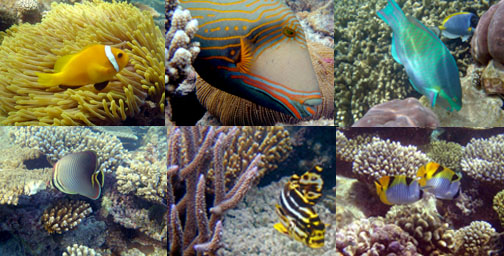 One interesting group of fish that are well worth observing on the reef at close quarters, are the many species of parrotfish. Contrary to age old assumption, many of the smaller species are not the mindless coral munching machines that they are commonly made out to be. They can actually be seen to graze ‘around’ the bases of corals, feeding on coralline algae and various algal and bio films, only occasionally taking bites from encrusting species that grow in massive formations. It appears in many cases that the vast majority of plating, branching, and folios hard coral species are completely ignored. This surely gives some ammunition to the idea that some of these species may well be applicable to reef aquaria and deserve further investigation. For sheer colour, many of these fish match or even surpass some of our more commonly imported and problematic angelfish species. But size and mobility is an issue that would need taking account of. Sadly these fish wouldn’t be applicable to smaller aquaria where they would feel cramped. Even for small individuals a 6’x2’x2’ aquarium would be a minimum starting point in my opinion.
One interesting group of fish that are well worth observing on the reef at close quarters, are the many species of parrotfish. Contrary to age old assumption, many of the smaller species are not the mindless coral munching machines that they are commonly made out to be. They can actually be seen to graze ‘around’ the bases of corals, feeding on coralline algae and various algal and bio films, only occasionally taking bites from encrusting species that grow in massive formations. It appears in many cases that the vast majority of plating, branching, and folios hard coral species are completely ignored. This surely gives some ammunition to the idea that some of these species may well be applicable to reef aquaria and deserve further investigation. For sheer colour, many of these fish match or even surpass some of our more commonly imported and problematic angelfish species. But size and mobility is an issue that would need taking account of. Sadly these fish wouldn’t be applicable to smaller aquaria where they would feel cramped. Even for small individuals a 6’x2’x2’ aquarium would be a minimum starting point in my opinion.
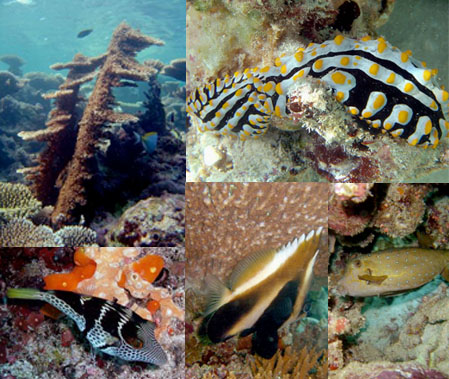 Moving forward across the crest to the reef slope, we gradually drop down away from the main effects of direct wave surge, where we start to see larger and larger plating formations, many of which are in excess of 10’ across. What’s fascinating in this area is what happens to a colony when it grows to such a size that it’s base can no longer support it’s weight, or storm surge breaks the head away so it falls onto its side. In a lot of cases the colony will start to grow new horizontal plates outward from the now vertical colony creating stunning multi-tiered structures. It’s along this region that we also start to encounter some of the more interesting fish species such as the Slingjaws, Boxfish, Puffers, and Angels. Free-diving down just a short distance we can also start looking under the large coral heads to see what lurks beneath. There we may find some of the more delicate and shade preferring corals such as the beautiful Plerogyra sinuosa and many secretive fish species. In one instance, a dive down to peer into a crevice was met with a face to face encounter with a fully grown titan trigger, obviously in a state of relaxed bliss, laid on its side, getting a full work over from a resident pair of cleaner wrasse.
Moving forward across the crest to the reef slope, we gradually drop down away from the main effects of direct wave surge, where we start to see larger and larger plating formations, many of which are in excess of 10’ across. What’s fascinating in this area is what happens to a colony when it grows to such a size that it’s base can no longer support it’s weight, or storm surge breaks the head away so it falls onto its side. In a lot of cases the colony will start to grow new horizontal plates outward from the now vertical colony creating stunning multi-tiered structures. It’s along this region that we also start to encounter some of the more interesting fish species such as the Slingjaws, Boxfish, Puffers, and Angels. Free-diving down just a short distance we can also start looking under the large coral heads to see what lurks beneath. There we may find some of the more delicate and shade preferring corals such as the beautiful Plerogyra sinuosa and many secretive fish species. In one instance, a dive down to peer into a crevice was met with a face to face encounter with a fully grown titan trigger, obviously in a state of relaxed bliss, laid on its side, getting a full work over from a resident pair of cleaner wrasse.
The diversity and health of this particular reef compared to many of the surrounding reefs in the Maldives which suffered sever damage during the 1998 El-Nino event, raises interesting questions and concerns. It is quite feasible that reefs such as this could be used as a source point for cultivating and transporting coral fragments to previously damaged areas, putting back ‘over the long term’ diversity and essential protective coverage that has since been lost. Such practices may also offer some long term insight into why some species grow to dominate some locations at the expense of other species, whilst other locations can maintain a more even and wider distribution of species. If nothing else, oasis locations of high diversity such as Velidhu should be cherished as natural distribution points, putting back at times of spawning a huge array of new life that can travel and resettle in previously decimated nearby locations.
To finish this write up though, I will end on something not so aquarium related, but an experience that still captivates me intensely every time it happens. A short distance from the main atoll lays an underwater sand bank area that rises up from the seafloor to around 10 meters shy of the surface. This uprising causes a compression of plankton density as water gets passed upwards and across the top of it. Needless to say, where you get such dense populations of plankton, you will also commonly encounter Manta rays. On this particular trip we were incredibly lucky to come across not one but three congregating families that had all come together for the feast. Numbering over 17 in total, they were so intent on their feeding that they would simply glide, flip and spiral in and out of the observers, frequently coming to within inches of making contact. Although tempting as it may be to reach out and touch such beautiful and majestic creatures when they come so close, it is in fact a bad idea. The Manta’s mucus coating helps protect it from parasite infestations. Stroking or touching them can remove, or at best damage this coating leaving the animal susceptible to infection, so the motto here is definitely ‘look but don’t touch’ regardless of how captivated you are.
 So with all that out of the way, I will leave you with a parting image of an underwater sunset. Taken across the reef flat just as the sun was going down in the distance above the surface, giving rise to the affect you see below. I will also give credit where it is due— in this case to my wife Emma who it appears has a natural flare for capturing underwater landscapes far better than I. So whilst I will take credit for the close up images, I will also thank Emma for remembering to capture the ‘bigger picture’ whilst I frequently had my face buried inside a crevice or coral head.
So with all that out of the way, I will leave you with a parting image of an underwater sunset. Taken across the reef flat just as the sun was going down in the distance above the surface, giving rise to the affect you see below. I will also give credit where it is due— in this case to my wife Emma who it appears has a natural flare for capturing underwater landscapes far better than I. So whilst I will take credit for the close up images, I will also thank Emma for remembering to capture the ‘bigger picture’ whilst I frequently had my face buried inside a crevice or coral head.
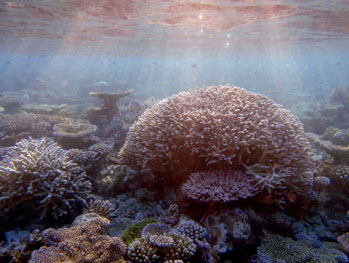 If you get the chance to visit the Maldives, I would strongly encourage a spell on Velidhu. It really is a world class reef in every sense.
If you get the chance to visit the Maldives, I would strongly encourage a spell on Velidhu. It really is a world class reef in every sense.
Simon Garratt O.C.R.D
All images copyright Simon Garratt
Emma Garratt



0 Comments